Our Doctors are experienced in a wide variety of orthopedic procedures. Below we have listed our most common procedures, but we care more than happy to consult on any orthopedic procedure that may be needed.
Amputation Toe or Limb
When a limb or toe is affected by cancer, or has non repairable trauma, an amputation may be the best treatment option. We make every reasonable effort to avoid amputation, but for some cases it’s the most appropriate treatment plan.
Amputation of Toe $950.00 – $1,200
Amputation limb of Puppy or Kitten under 12 weeks- $550 – $750
Amputation of Limb – $950 – $1,500
Bone Biopsy
If a bone neoplasia is suspected, we can perform a bone biopsy. The cost of the lab test ( histopathology ) are included for this procedure. We will also perform an ultrasound of the regional lymphnodes, and three view chest radiographs to evaluate for metastatic disease.
$850.00 – $950.00
Cranial Cruciate Ligament Repairs
Cranial cruciate ligament ( CrCL ) tears are the number one cause of rear leg lameness in dogs. Since the late 1990’s our understanding of this disease has made great advances. At the core of the problem is either chronic or acute stress on the CrCL that eventually results in its failure and degenerative changes in the knee. Once thought to be mainly a disorder of large breed dogs, we now recognize the disease is just as common in all sizes of dogs. Here at VetSurgical the majority of repairs performed by our doctor are in medium and small breed dogs, but we also have found success in even the giant breeds of dogs.
For the best long term outcome all pets that suffer partial or full CrCL tears should be considered for surgical repair. The belief that dogs under 40 lbs do not need surgery is an old and inaccurate position that is counter to our decades of experiences.
Dr. Hatcher, our lead surgeon, has more than 2 decades of experience in CrCL treatments. Soon after graduation, in 2001, he was routinely performing lateral suture repairs on a regular basis. Even assisting in wet labs teaching other practitioners how to perform the procedure. Stifle disease, such as management of CrCL injuries and Patella Luxation repairs, has evolved into his area of expertise. In 2012, Dr. Hatcher was certified in TTA repair technique for CrCL rupture treatment. The TTA procedure had been long recognized by the ACVS as an equivalent procedure to the more expensive TPLO repair typically offered by boarded surgeons ( see details here ) . Recently though the ideal that TPLO may be a superior procedure by specialist has gained some support in one study. The study was found to be heavily biased and was considered to be of low quality by other researchers. Leaving the debate for what procedure was the best open. Our experience is that TTA remains a viable effective option for CrCL Disease, with hundred of positive outcomes to date. Though TTA is the primary repair method we now perform, we can still perform lateral suture repairs for those that have a complete break down of the support structures of the knee, or can not budget a TTA repair. Lateral sutures are still an acceptable repair option with fair long term prognosis. It is our view that either TTA or Lateral Suture procedures are more acceptable than a pet not getting surgical treatment for a CrCL rupture if specialty care is unaffordable to the pet owner.
Our doctors are experienced in early detection of partial CrCL injuries, and we advocate for early intervention before the CrCL suffers a complete failure. When a TTA is performed with a partial tear the CRCL has the opportunity to regain some of its integrity, and some of its functions can remain. This allows for even better long term function of the knee.
All CrCR repairs will have radiographs performed prior to surgery to rule out any other disease or complicating factors. It is very common for pets suffering CrCL to have other abnormalities. We often find, specially in chronic cases, the pet suffers from bilateral CrCL tears, degenerative changes to the hips, lumbar stenosis, arthritis, and patella luxations. Pets with these additional concerns will possible have a longer recovery time, and may have a less favorable long term prognosis as hip and lower back pain may contribute to continued rear limb lameness and discomfort.
Recovery time varies, but typically with in 6-8 weeks pets are doing well. After surgery it is imperative that the pets excessive is restricted. They must not be encouraged to run, spin, jump, or rough house while they recover. Crate confinement is highly encouraged during the recovery phase. Pets that can not be restricted or confined may not be good surgical candidates. If you have any concerns we are happy to discuss them prior to scheduling the procure.
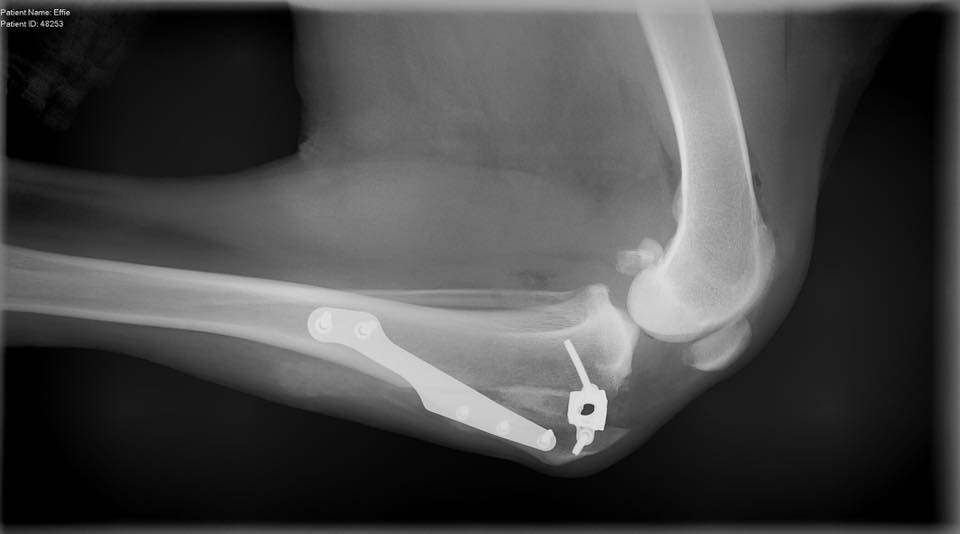
Extracapsulare Laterial Suture Repair – $ 1,800
TTA Repair – $2,000.00- $2,500.00
Femoral Head Osteotomy
Femoral head osteotomy (FHO) is generally considered a salvage procedure. In our experience we have found FHO it to be a very effective treatment option for a wide variety of hip issues. We have found that all cases we have performed this procedure do well and adapt to the use of the limb with very little pain and discomfort.
FHO is typically considered for dislocations of the hip joint, fractures of the acetabulum, fractures of the head or neck of the femur. It can also be considered for sever hip arthritis or dysplasia.
$1,200 – $1,900
Fracture Repair
There is not one type of bone our doctors have not successfully repaired. From the common fractured legs to the more unusually jaw, nose, ribs, skull, muzzle, and even backs. We are equipped with a wide assortment of pins, wires, plates, external fixtures, bone anchors, and bone grafting materials to meet the needs of almost any fracture we might see. Due to the wide range of possible types of fractures, the best way to fix each is different and there is a huge range in cost. We are happy to evaluate any radiographs your family veterinarian has taken and provide a more accurate treatment plan cost.
After surgery it is critical the pet be confined and exercise is strictly controlled to reduce any complications with implant failure.
It is rare that bandaging and splinting alone are appropriate for fractures in pets. The rare exception are mild fractures of the toes. We hope with our lower affordable fees that more pets will be able to get a more acceptable surgical repair and not managed with bandages or splints that can have high complication rates, and contribute to muscle atrophy and joint stiffness.
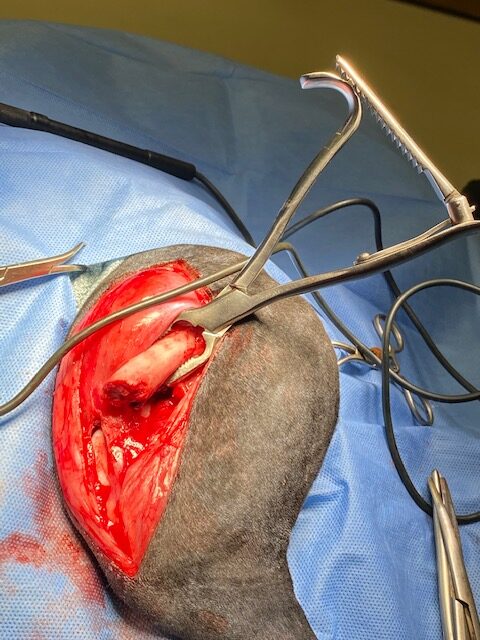
Fractured Femur
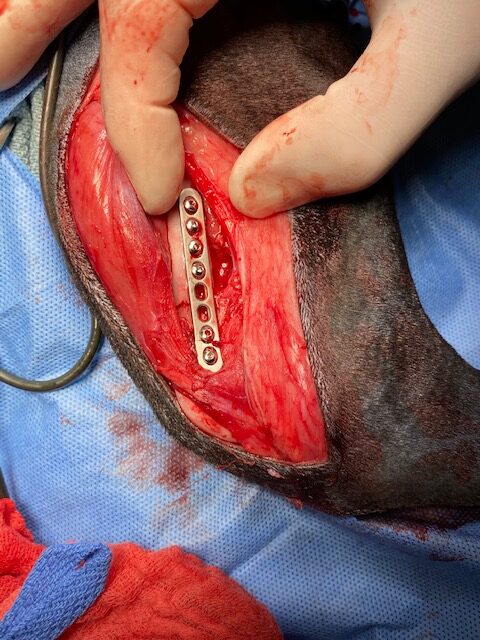
Review of radiographs or consult needed to give accurate treatment cost. $900 – $3,000
Patella Luxations
Patella luxations can be secondary to trauma or more commonly a developmental defect. They are staged from 1-4. Though Stage 1 are painful when they occur, they cause infrequent issues and may not need correction. Stage 2 and 3 luxations move around more and cause more chronic pain and development of arthritis and wear the cartilage down in the knee. These often do better when repaired. Stage 4 are out of socket all the time, and vary in how much pain they cause from none, to keeping the dog from being able to walk. Stage 4 have many challenges and a consultation will be needed before scheduling surgery. Not all Stage 4 luxations are affordable treated with surgical corrections.
It is now recognized that patella luxations can contribute to failure of the Cranial Cruciate Ligament. It is not uncommon to find a pet with a CrCL rupture also has a patella luxation in that knee. By performing a TTA we can address both conditions. because of the association we recommend stage 2 and 3 patella luxations be considered for repair before failure of the CrCL occurs. It is not uncommon for a pet not to have any clinical lameness from their patella luxation until a partial or complete tear of the CrCL occurs. So on occasion we will not be able to fully understand the severity of your pet’s knee disorder until surgery.
What to look for to know your pet needs surgery for their Patella Luxations!
- Has two or more episodes of lameness within 3 to 6 months that last more than 48 hrs, or needed pain medications.
- Pet has stopped trying to jump on furniture or beds. Pet my now cry or beg for you to be placed on furniture or beds.
- Pet misses, or unable to jump onto furniture when they once were able to.
- Pet has hesitation climbing stairs or jumping onto furniture
- Pet now struggles with stairs.
- Pet has always struggled with stairs or jumping onto furniture.
- Pet regular “skips” or misses a few steps when running.
- Pet can no longer take as long of a walk as they use to, or must rest more often on walks.
- Has evidence of degenerative joint disease ( arthritis ) on radiographs.
Stage 2 & 3 Luxation – $1,200.00- $1,500.00
Stage 2 or 3 Luxation with CrCL Rupture – $2,000 – $2,500.00
Stage 4 – Needs consult for full treatment plan cost and assessment.
Tail Amputation
Tails need amputation most commonly due to trauma of some kind, occasional it is needed to treat a tumor on the tail. Also, in some Bulldogs removal of severely cork screwed tails may help resolve chronic tail fold infections, and pain.
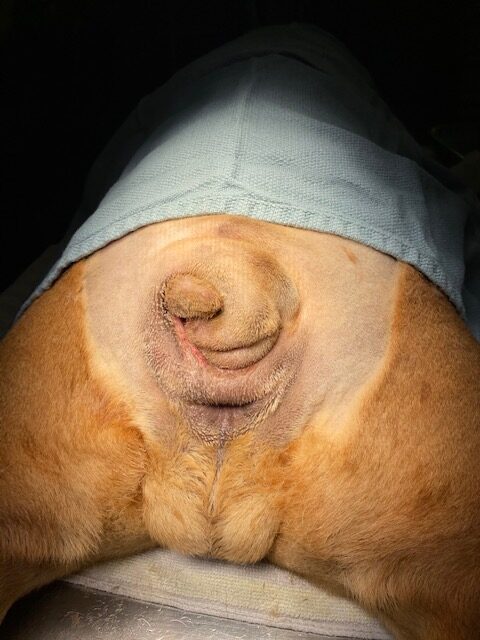
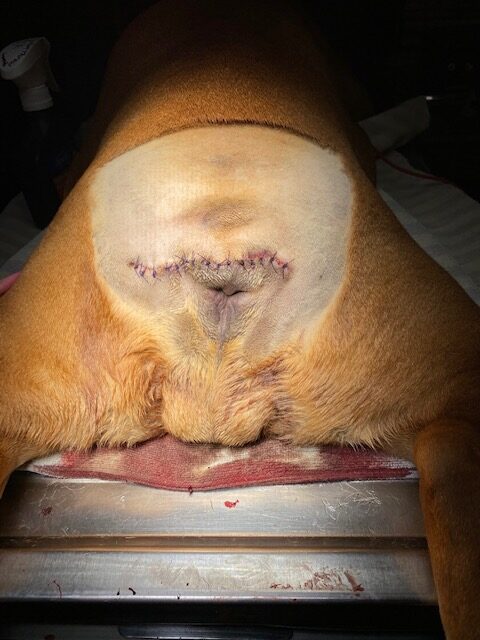
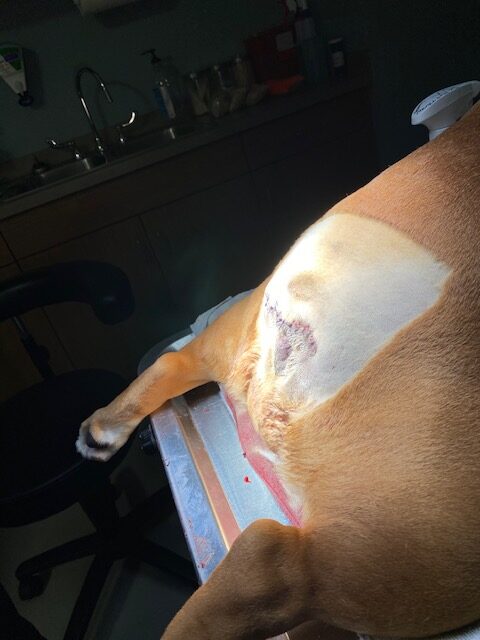
$550 – $1200
Unlisted Orthopedic Procedures
If there is a procedure your pet needs not listed please contact us. Our doctors are experienced in a wide range of procedures and we have listed only the most common. Once we review records or perform a consult we can discus if we can help you with your pets surgical needs.
Review of records or consult needed to provide accurate treatment plan cost.



